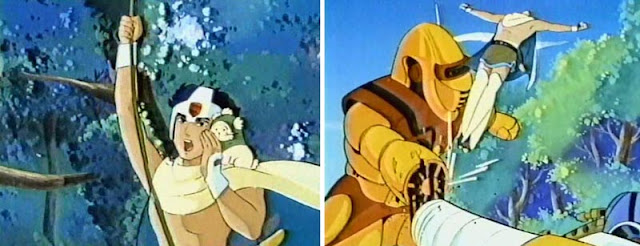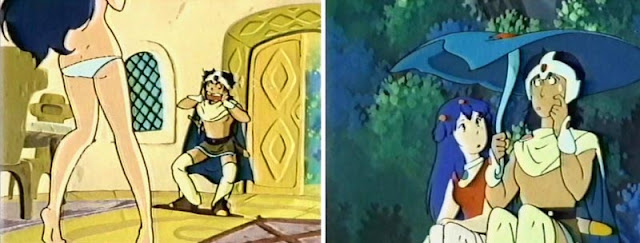The theme song asks us to show it our space, a mighty jungle
call echoes as a hero swings from vine to vine, and a beautiful space traveler
escapes evil robots! Is it Tarzan or Star Wars - or both? This is Tatsunoko’s
1984 series OKAWARI-BOY Starzan S, a goofy
romp through two continents’ worth of pop culture, delivering comedy, action,
and romance. Mostly comedy. Fondly remembered by viewers who were too few to
keep this series alive, the show was cancelled early and vanished utterly. What
is the mystery of Starzan S?
Somewhere in the galaxy the planet Kirakira is troubled. The
Senobi tribe wants to be left alone in their forests, but the Robot tribe of,
naturally, robots, are desperate for natural resources to fuel their robot
lifestyle. Only one thing protects the Senobi- our hero, the OKAWARI-BOY
Starzan S who defeats the schemes of Robot leader Darth Bellow and his
mechanical monsters with equal doses of Tarzan vine-swinging, Magnus Robot
Fighter robot punching, and various transforming mechanical devices that
coincidentally make great toys.
 |
| Starzan Yell, Starzan Kick |
Into this quaint pop culture remix crash-lands Jun Yagami.
Armed only with some blurry photos, a mini-skirt, and a collapsible ray-gun, this
beautiful teenage space traveler is searching for her missing father, who
vanished while tracking down a legendary space utopia named “Paratopia.”
Hot on Jun’s space-booted heels come the Maneko clan in
their garish candelabra of a starship. Mama Maneko, convinced Paratopia holds
the secret to eternal youth, is the matriarch of a toilet-paper dynasty. Her
daughter Leeds is a haughty would-be beauty, and Leeds ’
henpecked husband Hachiro takes abuse from them both. Meanwhile, their son
Ebirusu, a comedy version of Vegas-era Elvis Presley, has only one goal in
mind, the hand of the lovely Jun. Disabled in a great cosmic storm, both
parties crash-land on Kirakira. Sides are quickly chosen; the Manekos wind up
with the Robots while Jun is rescued by the God Of The Jungle, Starzan!
 |
| the Maneko family album |
Yes, Starzan, who oscillates between being a dashing warrior
or a short goof, who can defeat robots with his mighty blows yet occasionally
trip over his own feet, and whose first glimpse of Jun begins a teenage space
romance that will shake the very foundations of Kirakira, and perhaps the
galaxy itself!
OKAWARI-BOY Starzan S
aired in Urashiman’s old Fuji-TV timeslot, Saturdays at 6:30pm , from January to August 1984. Starzan
underperformed in the ratings and the show was replaced by an even more obscure
Tatsunoko series, the auto-mechanic adventure Yoroshiku Mechadoc. But for 34
weeks viewers would thrill to Starzan, his little Ewokish buddy Mutan, and the
friendly Senobi tribe’s struggle to protect Jun from the rampaging Robots and
whatever nutty scheme Ma Maneko and her dopey clan were pushing. The theme song
“Show Me Your Space” was sung by Poplar, aka Sumiko Fukuda, who’d later sing
tunes for Dream Warrior Wingman and Disney’s Beauty And The Beast. Yoshitaka
Amano is credited as Starzan S character designer, but the rounded, soft
features betray the hand of Takayuki Goto, who'd work on other Tatsunoko
projects like Zillion and features as varied as the chicken comedy Gu Gu Ganmo
and the cyborg non-comedy Appleseed. The animation is fluid, the music is
great, the characters and colors are bouncy and 80s, and Jun takes a lot of
baths and shows a lot of her space. To be fair, so does Starzan; equal
opportunity fanservice in action.
 |
| the course of outer space teenage romance never runs smooth |
An SF comedy, Starzan S has plenty of monsters, aliens,
spaceships, dimensional warps, and other genre staples. Starzan’s main mecha,
the transforming gorilla-bird-plesiosaur-buffalo Mecha Starzan S, provides much
of the show’s required 1980s anime show transforming-mecha footage. But Starzan
S unabashedly ditches the sci-fi for comedy, never hesitating to abandon its
lead in favor of whatever crazy scheme or sad character defect of the Manekos
is driving that week’s script (any resemblance to Tatsunoko’s earlier bad-guy
focused Time Bokan series is purely intentional).
 |
| Hachiro in an unusual mood, Leeds and Maneko are not impressed |
Grandma Maneko’s character was based on singer, arts patron,
and industrialist Masako “Pink Billionairess” Ohya, who reportedly owned 3600
pink dresses and six golf courses. Rumor has it her daughter Leeds
was based on screen legend Elizabeth Taylor. Leeds in turn dominates her diminutive,
frilly-collared husband Hachiro (modeled on boxer-turned comedian Octopus
Hachiro), and everybody indulges Ebirusu in what is described as his “illicit
love” for Jun Yagami, herself a take on the real-life singer Junko Yagami, who
recorded songs for Final Yamato, a pile of hit singles and albums, and now
lives in the United States.
 |
| obligatory Mojo Nixon reference |
The heavy lifting in these harebrained Maneko stratagems is
usually carried out by hapless Robot tribesbots. The Robots are led by Darth
Bellow, a diminutive Darth Vader (voiced by Darth Vader’s Japanese voice actor
Toru “Dr. Nambu” Ohira), but their ultimate ruler is a maniacal Barbie doll
named “Mother” who resides in a giant rice cooker, and their battle leader is
Tetsujin Ultra Z, a dopey cross between Tetsujin-28 and Ultraman. In peaceful
contrast, the diminutive Senobi people live an idyllic existence under the
gentle guidance of their leader, the kindly… wait for it… Obi-Wan Senobi.
 |
| Darth Bellow, Tetsujin Ultra Z in super pose |
The pieces of Starzan S fall into place early and the show
settles into its Jun-capturing, Starzan-rescuing, Paratopia-questing groove.
Starzan’s face gets stuck in goofy mode and he becomes a masked tokusatsu hero.
An amnesia-causing tidal wave isolates Jun and Ebirusu – is this his big chance
for love? Starzan shows Jun his secret
jungle home, an upside-down wrecked spaceship now home to weird nightclubbing
aliens, complete with a Sex Pistols needle drop. Ma Maneko has the Robots
construct a giant angry Buddha Maneko statue robot; what could go wrong?
There’s a visit Mutan’s home planet, a dead ringer for the Ewok-infested moon
of Endor, and we learn how he and Starzan met. Jun and Starzan and the rest of
the cast travel to Earth where the mystery of Starzan’s heritage is revealed,
and the bankrupt Maneko family’s possessions are traumatically auctioned off.
On their return to Kirakira, the evidence all points to one conclusion – that
the show is almost over and they’d better wrap things up! Paratopia’s secret is
revealed partly through the viewing of hundreds of Beta videotapes, the dark
mystery behind Darth Bellow is solved, the Robot and Senobi tribes bury the
robot hatchet, and peace finally returns to the beautiful planet Kirakira,
where the triumphant jungle yell of Starzan still echoes through the forest.
 |
| Starzan S records, books, toys |
So the big question is, what the heck does “Okawari Boy”
mean, anyway? Well, “okawari” is a
Japanese expression used when requesting
a second helping of food or another drink, the “kawari” meaning “instead of
something” or “replacement”. So in the context of Starzan being a replacement
for Tarzan, it makes sense. I guess. Sure. Why not. The other big question is, what happened to
Starzan S?
The show never even had the courtesy of a home video release;
all that survive are home-taped TV broadcasts. Tatsunoko shamelessly mines its
own back catalog for concepts and characters, yet no reboot for Starzan S. Why
no revival? Some theories: perhaps a show starring characters based on real
people (Maneko, Ebirusu, Jun) and thinly disguised parodies of extant,
copyrighted fictional characters (Darth Bellow, Starzan) is bound to attract
the attention of somebody’s legal department somewhere, attention the
notoriously lawsuit-averse Japanese are loath to attract. Add Starzan’s weak TV
reception to the mix, and it’s safe to assume Tatsunoko was/is reluctant to throw
good money after bad.
 |
| Starzan S, Mutan, and Ebiten, Ojinbo, and Kakasan of the Senobi |
Starzan S was heavy on the cultural Japanese gags so it’s unsurprising
that international markets were also slow to warm to the series, though Starzan
S did make it to Spain
and Korea and
two reported VHS releases in Poland .
Without any sort of (non-Polish) home video release, Starzan S vanished, and like
other obscure Tatsunoko series "Animentary Ketsudan" and "Meiyo no Sukouto", the series was only able to make a dent among Western anime fans
through international tape-trading; an already tenuous link dependent upon a
select, obsessive-compulsive group of Japanese fans.
Still, let’s not be too maudlin. The viewing public’s
gestalt mind probably made the right call; OKAWARI-BOY Starzan S is manifestly a 1984 artifact, a product of that final pop of the
anime boom, a cute 34 episode SF comedy. Wackier than Urashiman, not as wacky
as Ippatsuman, smart (or lucky) enough to not overstay its welcome, leaving
behind nothing more than some toys, some fond memories, a giant wrecked Buddha
Maneko robot, and the echoing call of the God Of The Jungle. Will we ever find our own Paratopia of a
Starzan S re-release on DVD or BD or
streaming or some new, heretofore unheard of technology? Will we, once again,
be able to show OKAWARI-BOY Starzan S all our
spaces?
EDITED TO ADD: in 2017 Starzan S got a Blu-Ray release, proving once again all it takes is a Let's Anime column to shift the cosmic forces towards the axis of righteousness. I promise to always use this power for the betterment of mankind.
-Dave Merrill
Thanks for reading Let's Anime! If you enjoyed it and want to show your appreciation for what we do here as part of the Mister Kitty Dot Net world, please consider joining our Patreon!



4 comments:
Excellent write up! I forgot when/how I came discovered this, but I fell in love with the opening and I've been drawn to it since. A few random episodes have been popping up on YT lately. I liked what I saw, and it'd be nice if this got some sort of re-release.
It also took me 10 years to realize the super adorable and silly ending credits used black face. Eep!
On the topic of long-forgotten 80's anime... got anything on Step Jun? I've seen images from it for ages, but apparently it hasn't been released on video, or had any reruns since the early 90's.
Retrosofa, thanks for the compliments! I was thinking about bringing up the whole Rats & Star thing that's going on in the end credits, but I decided to leave that can of worms unopened for now.
I have a children's book for Step Jun; maybe I'll get Rick to translate it like the Xabungle and Govarion books... according to Amazon.jp it got a DVD release, so it's out there on home video somewhere.
Whoops! You're right about Step Jun. It just got a DVD release in 2014.
Hello! I think Starzan S needs a global film remake. Here's the video called "the Starzan S intro"!
https://www.youtube.com/watch?v=wvxPjwppMlI
Now I'm talking about the show's title character of the same name! The lovable old Starzan that you reviewed is inspired by many of those Weissmuller and post-Weissmuller Tarzan actors, what do you think? I also learnt that his yell (which cooperates with a hand to hand sign language) is like that of Tarzan from the 1930s to the 1960s.
Post a Comment